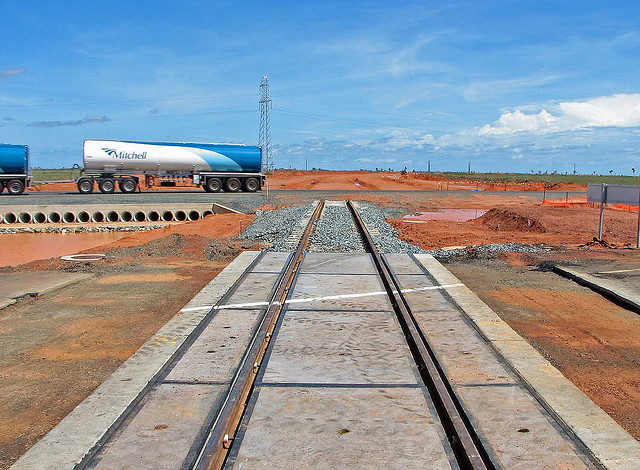Investing in northern infrastructure? Don’t forget to invest in resilience as well

The north of Australia is booming with recognition of significant export opportunities into Asian markets across a number commodity types. In the first quarter of 2014,
just over 90,000 cattle were exported from Darwin, mostly to Indonesia, but also to Vietnam, Malaysia, the Philippines and Brunei. More than
493,000 head were shipped in total that year and
615,062 head by the end of the 2015 reporting period. In addition to livestock export and agricultural development,
significant investments in energy production are evident with Chevron’s Gorgon Natural Gas Project and the Inpex Ichthys LNG Project, to name just two.
Promoting northern Australia as a bridge to southeastern and northern Asian markets by developing economic and trade opportunities makes sound strategic sense, a point that is generally well supported. Achieving this has required a forward look at infrastructure development needs and opportunities. So the publication of the
Northern Australia Infrastructure Audit Report in January and the
White Paper on Developing Northern Australia in June are timely. A suite of projected infrastructure components ranging from road and rail links, water supply and storage, relevant telecommunications assets and aviation and maritime terminus points are detailed in the White Paper, in particular.
A central intent of the White Paper was a
stocktake of northern Australia’s natural, human, geographic and strategic assets, and detail of options to further development of minerals, energy, agricultural, tourism, defence and other industries. The Paper, which was supported by comprehensive guidance from a
high-level advisory group, also provides a comprehensive assessment of risk exposures and impediments to realising such growth.
The detail and thinking represented in those studies provides a strong base for envisioning how networked infrastructure systems in Australia’s northern regions might be developed for both national betterment and providing capacity to deliver projected benefits of trade and business opportunities in Asia.
But those reports are only an initial step in an ongoing policy development process. More work needs to examine processes that detail how the current and projected (critical) infrastructure will remain resilient in order to protect and sustain the value gained by planned investment.
Also critical is the need to enhance the resilience of mobile telecommunication and broadcast infrastructures (radio and television) and the importance of improving freight network resistance to the impacts of floods and natural disasters. But the terms, ‘disaster resilience,’ ‘infrastructure interdependencies’ or ‘infrastructure resilience’ don’t appear in either the White Paper or the Infrastructure Audit Report.
While critically important infrastructure (assets) have been identified as central parts of investment planning and growth projections, more assessment is required on how to evaluate the effects on complex interconnected infrastructure systems from the impacts of natural disasters. Questions such as ‘can resilience, in context to the effects of natural hazards, be designed and built into new asset types or retro-fitted to existing infrastructure systems?’ need further consideration.
Changes to the way infrastructure systems are designed and maintained are needed particularly in the face of anticipated weather variability. We need to complement impact resistant infrastructure design (hardening) with
resilient design. While building robustness into infrastructure is standard practice, the complexity of interdependent systems and the increased incidence of extreme weather require a shift towards having (energy and telecommunications) infrastructures operating under a
‘safe-fail’ approach that key parts of infrastructure remain intact and functional to support continuity and resumption of services even if large segments of infrastructure fail.
The absence of resilience in infrastructure can be significant. For
example, after Hurricane Sandy, electricity supplies in Manhattan were lost for more than three days. In 2015, Chile experienced the equivalent of seven years of rain in 12 hours resulting in widespread loss of electricity. The cost of recovery from the 2013 typhoon Typhoon Haiyan was estimated at more than double the Philippines GDP.
Thus it would be useful to expand the predominantly economic assessment focus of the present Northern Infrastructure policy effort to include more analyses of how to incorporate notions of ‘resilience’ into the planned (critical) infrastructure elements in the north.
Proponents
need look no further than our own Attorney General’s Department, which recognises the importance of critical infrastructure and maintains a national strategy. Definitions of critical infrastructure in this strategy refer to those (physical and virtual) elements that provide essential services for everyday life (such as energy, food, water, transport, communications, health and banking and finance) which, if disrupted or degraded, could have a range of serious implications for business (including other infrastructure components), government and the community.
Similar definitions of critical infrastructure exist in
the US the
European Commission and
Canada.
While all of those national approaches to critical infrastructure include economic factors, they importantly include infrastructure vulnerabilities that link to debilitating impact on security, national economic security, national public health or safety, or any combination of those.
The current narrow approach to defining critical infrastructure issues in northern Australia planning is easily remedied by investing in more collaboration among the three Australian states and incorporation of guidance from the national strategy. In fact, the Queensland government’s release of a
new draft State Infrastructure plan could be even more helpful. According to the plan, critical infrastructure must be sustainable (in design) and resilient to the effects of natural disasters as an enabler of improving ability to recover functionality once lost or degraded.
Ineffective management and sustainment of infrastructure may contribute significant loss of invested value. Ultimately, failure to include a broad appreciation of the benefits of requisite variety in our thinking about resilience of critical infrastructure systems most definitely will.
 Print This Post
Print This Post